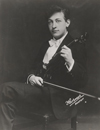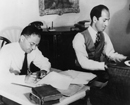All material found in the Press Releases section is provided by parties entirely independent of Musical America, which is not responsible for content.
Press Releases
MIM’s Next Special Exhibition to Feature More Than 100 Rare and Remarkable Flutes
The Magical Flute: Beauty, Enchantment, and Power opens November 7, 2025
PHOENIX (October 7, 2025) — On November 7, the Musical Instrument Museum (MIM)
opens The Magical Flute: Beauty, Enchantment, and Power, a special exhibition that celebrates
the resounding influence of the world’s first wind instrument. From ancient ceremonies to
contemporary stages, people around the world have used flutes to express the rich human
experience. This exhibition explores that legacy through more than 100 instruments that
reflect both the beauty of their craftsmanship and the depth of their meaning, plus clothing
and costume displays that enhance understanding of the flutes’ diverse cultural contexts.
“Throughout history and across the world, the flute has been used to express what it means
to be human,” says Matthew Zeller, MIM’s curator for Europe. “This exhibition showcases
the impressive physical and acoustic diversity of flutes, highlighting shared themes and
distinctive practices.”
The Magical Flute features finely crafted instruments that illustrate the breadth and quality
of MIM’s permanent collection—such as richly decorated ancient panpipes from the Nazca
people of Peru, an intricately carved wooden Maori koauau, and a flute made by Theobald
Boehm, perhaps the most important flute maker in European history—along with exceptional
loans from renowned institutions and private collectors. The exhibition showcases flutes
owned and played by internationally acclaimed musicians such as jazz flutist Herbie Mann,
Richard Egües of the Cuban charanga group Orquesta Aragón, Native American flutist
R. Carlos Nakai, and prolific studio musician Sheridon Stokes, who recorded memorable
solos for television shows and films, including Mission: Impossible, Jaws, and Titanic.
Instrument highlights include:
• An ancient Chinese yue bone flute, c. 6300–5400 BCE. This flute from the Xinglongwa
culture of ancient northeastern China was made approximately 8,000 years ago—
suggesting that music was already part of human life at the dawn of civilization.
Anonymous Loan
• Japanese emperor Go-Daigo’s hitoyogiri, early 14th c. This extraordinary Japanese flute
is one of two known hitoyogiri made for Japanese emperor Go-Daigo (1288–1339).
Its body is richly decorated with seven layers of lacquer and features elaborate dragon
and cloud motifs.
Loan courtesy of the Takao Oikawa Family
• Napoleon’s faceted glass flute, 1813. This faceted clear glass flute, a sister instrument to
James Madison’s crystal flute, has elegant silver keys and trimmings. It is one of three
flutes in the exhibition made by Claude Laurent, including a distinctive cobalt glass flute
owned by Napoleon’s brother, Louis Bonaparte.
Loan courtesy of Mark Leone
• James Galway’s gold flute, 2001. This flute, made of solid 18-karat gold and encrusted
with diamond accents, was owned and played by internationally renowned flute virtuoso
Sir James Galway, known as “the Man with the Golden Flute.”
MIM Collection, Gift of the Robert J. Ulrich and Diane Sillik Fund
• A Maya figural double duct flute, 600–900. The high-quality craftsmanship and detailed
decoration on this elaborate ancient Mesoamerican flute imply that it had great social
and ritual importance. Its sculpted figures include a mythological feathered reptile, and
its unusual sounds are reminiscent of birdlike warbles.
Loan courtesy of The Museum of Fine Arts, Houston, Gift of Frank Carroll
• ?do? belonging to a Bamileke chief, early 20th c. Fully beaded items, such as these two
large, elaborately horned flutes, are kept by chiefs of the Bamileke people of Cameroon,
along with other insignia that indicate their rank.
MIM Collection
The instruments on display are complemented by traditional clothing, ceremonial regalia,
and elaborate stage costuming that contextualize how flutes have been used to shape cultural
identities, convey status, and transport audiences during fantastic performances. Highlights
include costumes for productions of Mozart’s The Magic Flute: one by influential modernist
painter Marc Chagall for the Metropolitan Opera, and three by iconic British fashion designer
Dame Zandra Rhodes that were used by the Seattle Opera. The exhibition also features a suit
of samurai armor from the early to mid-19th century that shares a cho-mon butterfly crest with a
miyogiri in the exhibition, suggesting that both were associated with a prominent samurai clan.
The opening weekend of The Magical Flute: Beauty, Enchantment, and Power will be
celebrated with a three-day Signature Event at MIM on November 7, 8, and 9. The weekend
will include family-friendly activities such as live music performances, curator talks, and
instrument demonstrations.
For information about opening weekend and other exhibition programming, visit MIM.org.
Sponsored by the John & Joan D’Addario Foundation, Mary Ann & John Mangels, and PNC Bank
Supported by Christine Lindley, the Hao and Michelle Wang Foundation, and Jan & David Wood
The Musical Instrument Museum is located at 4725 E. Mayo Boulevard in Phoenix (corner of
Tatum and Mayo Boulevards, just south of Loop 101). For general museum information and a
full schedule of events, visit MIM.org or call 480.478.6000.
***
About MIM
The Musical Instrument Museum (MIM) enriches our world by collecting, preserving, and
making accessible an astonishing variety of musical instruments and performance videos
from every country in the world. MIM offers guests a welcoming and fun experience,
incomparable interactive technology, dynamic programming, and exceptional musical
performances. MIM fosters appreciation of the world’s diverse cultures by showing how we
innovate, adapt, and learn from each other to create music—the language of the soul.
To learn more about MIM, visit MIM.org.
Find MIM on Facebook: facebook.com/MIMphx
Instagram and YouTube: @MIMphx
TikTok: @MIM_phx
Media Contact
Sydney Rich
Communications Specialist
sydney.rich@MIM.org
480.245.6953





 FEATURED JOBS
FEATURED JOBS

 RENT A PHOTO
RENT A PHOTO


